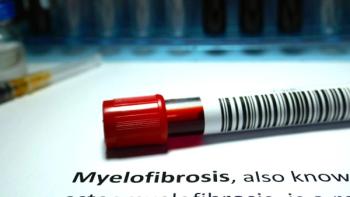The addition of the oral AKT inhibitor Truqap (capivasertib) to Zytiga (abiraterone acetate), prednisone and androgen deprivation therapy (ADT) extended investigator-assessed radiographic progression-free survival (rPFS) by 7.5 months compared with Zytiga, prednisone, ADT, and placebo in patients with PTEN-deficient de novo metastatic hormone-sensitive prostate cancer, according to results presented at the 2025 ESMO Congress.
After a median follow-up of 18.4 months, median rPFS with Truqap was 33.2 months compared with 25.7 months for placebo. Median overall survival was not yet reached at the time of analysis for either arm. There had been 267 events at the time of assessment, with 129 in the Truqap arm and 138 in the placebo group.
“The primary end point was met, showing an rPFS benefit with Truqap and Zytiga, with consistent benefits across clinical end points,” said Dr. Karim Fizazi, medical oncologist at Institut Gustave Roussy and Centre Oscar Lambret. “The rPFS in the control arm was only 25.7 months, highlighting the poor prognosis of this PTEN population.”
In the study, 1,012 patients received Zytiga at 1,000 milligrams (mg) with prednisone at 5 mg daily plus ADT. Patients were randomly assigned to Truqap at 400 mg twice daily for four days on and three days off (507 patients) or matched placebo (505 patients). PTEN deficiency was defined as more than 90% of malignant cells showing no cytoplasmic staining by immunohistochemistry. About 25% of screened patients met this criterion.
Baseline characteristics were similar between groups. Median age was 67 years with Truqap and 68 years with placebo. Total Gleason score was 8 or more in 78.5% and 79% of patients, and disease risk was high in 61.3% and 65.9%, respectively. Bone was the primary metastatic site in 91.1% and 92.5% of patients, and nearly two-thirds had an Eastern Cooperative Oncology Group performance score of 0, with the remainder scoring 1. About three-fourths of patients had high-volume disease.
Glossary
Radiographic Progression-Free Survival (rPFS): the length of time during and after treatment in which a patient’s cancer does not worsen as seen on imaging scans, such as CT, MRI, or bone scans.
Overall Survival (OS): the length of time from the start of treatment that patients are still alive, regardless of disease status.
Symptomatic Skeletal Event-Free Survival: the length of time a patient lives without experiencing serious bone-related complications caused by cancer, such as fractures, spinal cord compression, or needing radiation or surgery to the bone.
Castration Resistance: the point at which prostate cancer continues to grow or spread despite therapies that lower testosterone (such as ADT).
“Consistent with the poor prognosis of this PTEN-deficient prostate cancer population, most patients had high-risk, high-volume, high Gleason score disease,” Fizazi said.
Subgroup analyses showed similar improvements in rPFS with Truqap, although none met statistical significance. Time to next treatment was 37 months with Truqap compared with 28.5 months for placebo. Median symptomatic skeletal event-free survival was 42.5 months versus 37.3 months. Events included pathological fracture, spinal cord compression, radiation use, surgical intervention, and death.
Time to castration resistance was 29.5 months with Truqap compared with 22 months for placebo. Median time to PSA progression was not calculable at analysis, with 60 events in the Truqap arm compared with 82 in placebo. Pain progression was too early to measure.
Analyses by PTEN expression showed consistent rPFS benefit across all levels. With PTEN loss in 100% of cells, median rPFS was 34.1 months with Truqap compared with 22.1 months for placebo. Truqap also showed trends toward improved overall survival and secondary end points in higher PTEN-deficient populations.
Side effects were higher with Truqap. Grade 3 (severe) or higher (life-threatening) side effects occurred in 67% of patients versus 40.4% for placebo. Serious side effects occurred in 42.5% versus 26%. Side effects led to discontinuation in 18.3% versus 4.8%. Dose interruptions were required in 62.8% versus 26.8% and dose reductions in 29% versus 3.6%. Side effects leading to Zytiga discontinuation occurred in 9.5% versus 5.4%.
The most common side effects with Truqap compared with placebo were diarrhea (51.9% versus 8%), hyperglycemia (38% versus 12.9%), rash (35.4% versus 7%), anemia (23.9% versus 12.7%), and hypokalemia (22.1% versus 12.7%). “Side effects typical of Zytiga, such as hypertension, hypokalemia, and elevated liver enzymes, were similar between arms,” Fizazi said.
In early 2025, another study exploring Truqap in combination with docetaxel and ADT was halted after an interim analysis suggested potential lack of efficacy.
Outside prostate cancer, Truqap is FDA-approved with fulvestrant (Faslodex) for patients with hormone receptor-positive, HER2-negative locally advanced or metastatic breast cancer harboring one or more PIK3CA, AKT1, or PTEN alterations after progression on at least one prior endocrine regimen or recurrence within 12 months of adjuvant therapy.
References
- "A phase III study of capivasertib (capi) + abiraterone (abi) vs placebo (pbo) + abi in patients (pts) with PTEN deficient de novo metastatic hormone-sensitive prostate cancer (mHSPC): CAPItello-281," by Dr. Karim Fizazi, et al. Presented at: 2025 ESMO Congress; October 17-21, 2025; Berlin, Germany. Abstract 2383O.
- Update on CAPItello-280 phase III trial of Truqap in metastatic castration-resistant prostate cancer. News release. AstraZeneca. April 29, 2025. Accessed Oct. 19, 2025. https://www.astrazeneca.com/media-centre/press-releases/2025/update-on-capitello-280-phase-iii-trial.html
- FDA approves capivasertib with fulvestrant for breast cancer. FDA. November 16, 2023. Accessed May 1, 2025. https://www.fda.gov/drugs/resources-information-approved-drugs/fda-approves-capivasertib-fulvestrant-breast-cancer
For more news on cancer updates, research and education, don’t forget to subscribe to CURE®’s newsletters here.






